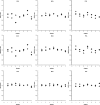Day-to-day test-retest variability of CBF, CMRO2, and OEF measurements using dynamic 15O PET studies
- PMID: 20700768
- PMCID: PMC3128261
- DOI: 10.1007/s11307-010-0382-1
Day-to-day test-retest variability of CBF, CMRO2, and OEF measurements using dynamic 15O PET studies
Abstract
Purpose: We assessed test-retest variability of cerebral blood flow (CBF), cerebral blood volume (CBV), cerebral metabolic rate of oxygen (CMRO(2)), and oxygen extraction fraction (OEF) measurements derived from dynamic (15)O positron emission tomography (PET) scans.
Procedures: In seven healthy volunteers, complete test-retest (15)O PET studies were obtained; test-retest variability and left-to-right ratios of CBF, CBV, OEF, and CMRO(2) in arterial flow territories were calculated.
Results: Whole-brain test-retest coefficients of variation for CBF, CBV, CMRO(2), and OEF were 8.8%, 13.8%, 5.3%, and 9.3%, respectively. Test-retest variability of CBV left-to-right ratios was <7.4% across all territories. Corresponding values for CBF, CMRO(2), and OEF were better, i.e., <4.5%, <4.0%, and <1.4%, respectively.
Conclusions: The test-retest variability of CMRO(2) measurements derived from dynamic (15)O PET scans is comparable to within-session test-retest variability derived from steady-state (15)O PET scans. Excellent regional test-retest variability was observed for CBF, CMRO(2), and OEF. Variability of absolute CBF and OEF measurements is probably affected by physiological day-to-day variability of CBF.
Figures




Similar articles
-
Database of normal human cerebral blood flow, cerebral blood volume, cerebral oxygen extraction fraction and cerebral metabolic rate of oxygen measured by positron emission tomography with 15O-labelled carbon dioxide or water, carbon monoxide and oxygen: a multicentre study in Japan.Eur J Nucl Med Mol Imaging. 2004 May;31(5):635-43. doi: 10.1007/s00259-003-1430-8. Epub 2004 Jan 17. Eur J Nucl Med Mol Imaging. 2004. PMID: 14730405 Clinical Trial.
-
PET measurements of CBF, OEF, and CMRO2 without arterial sampling in hyperacute ischemic stroke: method and error analysis.Ann Nucl Med. 2004 Feb;18(1):35-44. doi: 10.1007/BF02985612. Ann Nucl Med. 2004. PMID: 15072182 Clinical Trial.
-
Accuracy of a method using short inhalation of (15)O-O(2) for measuring cerebral oxygen extraction fraction with PET in healthy humans.J Nucl Med. 2004 May;45(5):765-70. J Nucl Med. 2004. PMID: 15136624
-
Human cerebral circulation: positron emission tomography studies.Ann Nucl Med. 2005 Apr;19(2):65-74. doi: 10.1007/BF03027383. Ann Nucl Med. 2005. PMID: 15909484 Review.
-
In-vivo positron emission tomography (PET) measurement of cerebral oxygen metabolism in small animals.Yakugaku Zasshi. 2008 Sep;128(9):1267-73. doi: 10.1248/yakushi.128.1267. Yakugaku Zasshi. 2008. PMID: 18758140 Review.
Cited by
-
Test-Retest Variability of Relative Tracer Delivery Rate as Measured by [11C]PiB.Mol Imaging Biol. 2021 Jun;23(3):335-339. doi: 10.1007/s11307-021-01606-z. Epub 2021 Apr 21. Mol Imaging Biol. 2021. PMID: 33884565 Free PMC article.
-
Quantifying reperfusion of the ischemic region on whole-brain computed tomography perfusion.J Cereb Blood Flow Metab. 2017 Jun;37(6):2125-2136. doi: 10.1177/0271678X16661338. Epub 2016 Jan 1. J Cereb Blood Flow Metab. 2017. PMID: 27461903 Free PMC article.
-
Comparison of velocity- and acceleration-selective arterial spin labeling with [15O]H2O positron emission tomography.J Cereb Blood Flow Metab. 2015 Aug;35(8):1296-303. doi: 10.1038/jcbfm.2015.42. Epub 2015 Mar 18. J Cereb Blood Flow Metab. 2015. PMID: 25785831 Free PMC article. Clinical Trial.
-
Comparison of MRI methods for measuring whole-brain oxygen extraction fraction under different geometric conditions at 7T.J Neuroimaging. 2022 May;32(3):442-458. doi: 10.1111/jon.12975. Epub 2022 Feb 6. J Neuroimaging. 2022. PMID: 35128747 Free PMC article.
-
Regional Reproducibility of BOLD Calibration Parameter M, OEF and Resting-State CMRO2 Measurements with QUO2 MRI.PLoS One. 2016 Sep 20;11(9):e0163071. doi: 10.1371/journal.pone.0163071. eCollection 2016. PLoS One. 2016. PMID: 27649493 Free PMC article.
References
-
- Frackowiak RS, Lenzi GL, Jones T, Heather JD. Quantitative measurement of regional cerebral blood flow and oxygen metabolism in man using 15O and positron emission tomography: theory, procedure, and normal values. J Comput Assist Tomogr. 1980;4:727–736. doi: 10.1097/00004728-198012000-00001. - DOI - PubMed
-
- Herscovitch P, Markham J, Raichle ME. Brain blood flow measured with intravenous H2(15)O. I. Theory and error analysis. J Nucl Med. 1983;24:782–789. - PubMed
Publication types
MeSH terms
Substances
LinkOut - more resources
Full Text Sources

